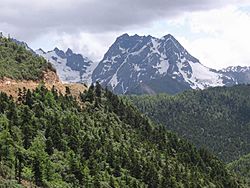Mixed forest facts for kids

Mixed forests are special places where different kinds of trees grow together. These forests are found in parts of the world that have a mild, wet climate, like places with four seasons. They are called "mixed" because they have both broadleaf trees (like oak or maple, which usually lose their leaves in autumn) and conifer trees (like pine or fir, which stay green all year).
These forests are very important for many animals and plants. They have several layers, almost like a tall building, where different creatures live.
Contents
Forest Layers: A Home for Many
Mixed forests have four main layers, each with its own unique plants and animals.
The Canopy: Forest Rooftop
The very top layer is called the canopy. This is where the tallest, oldest trees live. They can be as high as a 10-story building, reaching 33 to 66 meters (about 100 to 200 feet) tall! These big trees form a kind of roof over the forest, catching most of the sunlight. Many birds, insects, and even some mammals like squirrels live high up in the canopy.
The Understory: Below the Giants
Below the tall canopy trees is the understory. This layer is a bit shorter, usually 9 to 15 meters (30 to 50 feet) shorter than the canopy. The understory has three parts:
Smaller Trees and Saplings
The top part of the understory has smaller, grown-up trees. It also has saplings, which are young trees that are still growing. Some young canopy trees wait here for a space to open up in the main canopy so they can grow taller.
The Shrub Layer
Below the smaller trees is the shrub layer. This layer is made up of shorter, woody plants like bushes and large ferns. These plants don't grow as tall as trees, but they provide great hiding spots and food for many animals.
Ground Cover: Forest Floor Life
The lowest layer is the ground cover or herbaceous layer. This is the forest floor! It's usually the most diverse layer, meaning it has the most different kinds of plants. You'll find grasses, wildflowers, mosses, and small plants here. Many insects, small mammals, and amphibians live on the forest floor, finding food and shelter among the plants and fallen leaves.
Climate and Location
Mixed forests thrive in places with a temperate climate. This means they have warm summers, cool autumns, cold winters, and mild springs. They also need a lot of humidity, which means there's plenty of moisture in the air and soil, often from regular rain or snow.
These forests are found in many parts of the world, including:
- Eastern North America
- Parts of Europe
- East Asia (like China and Japan)
- Small areas in the Southern Hemisphere
The mix of broadleaf and conifer trees helps these forests adapt to the changing seasons. Broadleaf trees lose their leaves to save water in winter, while conifers keep their needles, allowing them to photosynthesize even in colder months.
Animals of Mixed Forests
Mixed forests are home to a wide variety of animals. The different layers of the forest provide many places to live and different kinds of food.
Mammals
You might find mammals like deer, bears, raccoons, squirrels, and foxes living here. They find food like nuts, berries, insects, and smaller animals. Some animals, like bears, might hibernate during the cold winter months.
Birds
Many types of birds live in mixed forests. Some build nests high in the canopy, while others prefer the lower branches or the shrub layer. Birds like woodpeckers, owls, and various songbirds are common. Many birds migrate to warmer places in winter.
Amphibians and Reptiles
The damp forest floor and nearby streams are perfect for amphibians like frogs, salamanders, and newts. Reptiles such as snakes and turtles can also be found, especially in sunnier spots or near water.
Insects
Insects are everywhere in mixed forests! They play a vital role in the ecosystem, from pollinating plants to breaking down dead leaves and wood. Butterflies, beetles, ants, and many other insects are important parts of the forest food web.
Importance of Mixed Forests
Mixed forests are incredibly important for our planet.
- Air Quality: Like all forests, they produce oxygen and absorb carbon dioxide, helping to clean the air we breathe.
- Water Cycle: They help regulate the water cycle by absorbing rainfall and slowly releasing it, which prevents floods and keeps rivers flowing.
- Biodiversity: They support a huge variety of plant and animal life, making them important hotspots for biodiversity.
- Natural Resources: They provide timber and other natural resources, but it's important to manage these resources sustainably.
Protecting these amazing forests is crucial for the health of our planet and all the creatures that call them home.
Images for kids
-
An example of temperate broadleaf and mixed forest in La Mauricie National Park, Quebec.
See also
 In Spanish: Bosques templados de frondosas y mixtos para niños
In Spanish: Bosques templados de frondosas y mixtos para niños


